Selecting a dinghy may be one of the most important decisions you’ll make as a commuter cruiser! Your dinghy will be your family car. Not only will it transport you to town for provisions and diesel, but be your magic carpet for adventures yet to be discovered. You’ll land on beaches untouched by footprints and paddle up unexplored rivers with flora and fauna most people can only see in a $60+ per person disney-type gropu adventure. In short, your dinghy is your ticket to fun while cruising!
So it should come as no surprise that selecting a dinghy is an extremely serious affair! 🙂 But fear not, it’s not as overwhelming as it might seem … especially if you’re trying to buy one while you’re off cruising because your choices will be severely limited unless you happen to be somewhere where one of the major manufacturers lives. For the best selection, buy your dinghy before you leave the US (or New Zealand or Europe).
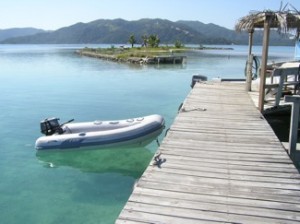
There are basically 4 major categories of dinghies … Inflatables, RIB Inflatables, Hard Dinghies (including sailing dinghies) and Foldable Hard Dinghies. Each has it’s advantages and disadvantages. There are also many alternative options to consider … kayaks, inflatable kayaks … anything that floats and can transport you somewhere could be considered a dinghy.
But before you can even consider which dinghy is right, you’ll need to put together some information. How many people will be regularly using the dinghy? How much combined weight are you looking to transport – routinely and also consider jerry jugging fuel or a full load of provisions? What do you want to do with your dinghy – snorkeling, diving, exploring, going to town? Where will you carry it aboard? Do you have davits or a lifting crane for the outboard? How much weight can you manage — can you lift the dinghy with the outboard on or does it always have to come off? Where will it stay on passages?
The overall recommendation is to buy the biggest dinghy your boat size and you can handle, both on deck and lifting for overnight safety. A bigger dinghy almost always translates into happier dinghy owners, unless the boat size and owners can’t handle it, in which case it’s usually for sale while they look for a smaller dinghy. Make sure to measure several times before you decide the maximum size dinghy your boat can handle.
Once you have given a bit of thought to all these considerations, it’s time to look at the alternatives.
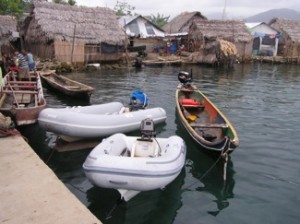
1. RIB Inflatables/Inflatables are without a doubt the dinghy most used in the Caribbean so we’ll examine those first. When evaluating an inflatable, first you’ll need to decide what type of floor constructions suits your style of cruising. Without a doubt, the best material is hypalon to endure the wicked tropical UV sunrays. Or you could spend a bunch of money getting canvas chaps fabricated for your inflatable to protect it from the sun. Personally, we’ve never liked canvas chaps, they slide making me afraid of slipping. Instead we religiously use 303 Aerospace Protectant as sunscreen on our inflatable hypalon with no UV deterioration detected over years in the tropical sun. We also store the dinghy upside down and cover it when we’re gone for six months. Hard bottom inflatables, usually called RIB’s, will have the best performance, but they sacrifice portability and foldability. There are many alternatives, but here are the major choices:
A. Roll Up Inflatables. When we started cruising, we had a little 8′ Caribe roll up dinghy. We loved it. It was purchased used from a friend that had it stolen in Miami and returned a month later, a bit worse for the wear. Since he had already replaced it, he sold it to us complete with patches and scuffs for a more than reasonable sum. That dinghy served us well for the first 6 years we owned Winterlude, even off cruising for the first 3 years. The Pros: small and light, rolled up to fit below in our quarterberth on passage; stable and dependable; hypalon material is the best; big enough tubes to keep us dry but not so oversized as to be cumbersome; handled well with our hp Tohatsu outboard – would even plane with just the 2 of us after we added the doel fins on the outboard and pumped up the tubes as advised by Defender; was light enough for us to handle easily and raise with the halyard to hang on the boat’s hip at night with the outboard on. The Cons: small, very crowded with lots of provisions; much slower than others when heading out snorkeling; wet in high winds and waves compared to larger dinghies; eventually developed a slow tiny leak that we never could fix at a tube seam (note – a friend bought it and still uses it regularly, so it was just an inconvenience); the flat bottom was very stable but we had to watch carefully not to put the speargun tip though the spaces left between fiberglass floorboards!
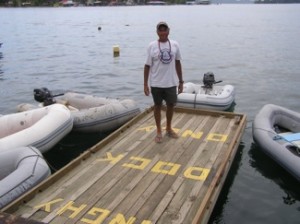
B. High Pressure Air Floor Inflatables. While we’re not as familiar with this type of dinghy, it seemed like the early versions weren’t stiff enough to really hold people and cargo with a stiff floor feeling. The newer high pressure air floor inflatables seem to be much better and are slowly becoming more popular. I’m guessing that the major advantage is the light weight and foldability/compact to store. Even newer versions come in a V Hull that add performance aspects more common to a RIB.
C. RIB … fiberglass or aluminum. Our “new” AB Inflatable is an aluminum RIB, is 9′ long — a huge increase from our 8’3″ Caribe! 🙂 We picked an aluminum floor rather than the standard fiberglass because of the weight savings. We love the dinghy, but it took a bit of getting used to. It is MUCH tippier than our flat bottom roll up Caribe. With the same 8 hp Tohatsu outboard, it is faster, skimming the water almost keeping up with our friends bigger dinghies with more horsepower. This translates into more range to explore easily. The hypalon-neoprene tubes are actually slightly smaller than our old 8’3″ Caribe, but the deep V hull makes the ride drier despite the smaller tubes. It’s light and we have no hesitation to drag it up on any beach, rocky, shells, anything, where before with the rollup we were always more hesitant and even had dinghy transom wheels on it for awhile to avoid tearing up the bottom. The RIB obviously is less flexible about storage. We cannot un-inflate it, roll up and throw it below in a matter of minutes like we did the Caribe. But we made a place on the foredeck for when we’re underway and we lift it via a halyard on the boat’s hip overnight.
2. Hard Dinghies … if you have room aboard and like a hard dinghy, you may consider a hard dinghy. In general the smaller hard dinghies have less initial stability than their wider inflatable counterparts. In other words, you may feel a bit more unstable stepping into a hard dinghy than an inflatable. However they may be somewhat less expensive and you won’t have to worry about the tubes chafing or deteriorating with UV. In general hard dinghies will carry less cargo than their inflatable counterparts. But inflatables won’t row well, so if you like rowing — and many enjoy it for exercise as well as transportation, and the quiet — you may consider a hard dinghy. Hard dinghies are very rugged, even more so that RIB inflatables – you never have to worry about dragging them up on any type of surface. You also don’t have to worry about tying up your hard dinghy with zillions of other dinghies at a dinghy dock – no puncture possibility. There’s very little demand on the black market for hard dinghies — i.e. the chances of your hard dinghy being stolen are very slim. One other reason some cruisers like a hard dinghy is to add a sailing kit – it’s very cool to be anchored in a protected anchorage and sail around exploring in your shallow draft sailing dinghy. I have often envied those off for a sunset cruise in their sailing dinghies. But the tradeoff is lack of flexibility and the possibility of banging up your hull with the hard dinghy.
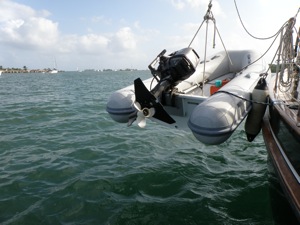
3. Fold Up Dinghies. There are various brands, but the only one I actually saw cruisers using was Porta-Bote. Owners like that it’s virtually indistructable, can be stored easily in its length and height plus a few inches for width, takes about 10 minutes to put together (once you get used to it), has a large area for cargo, can carry three adults, is easy to row, and will plane with a small outboard. The cons include feeling soft underfoot and difficulty getting in and out — especially if swimming, snorkeling or diving. Another plus is the relatively low cost. Cruisers we knew with Porta-Bote’s were convinced that they were the best dinghy option. But the rest of us remain skeptical.
Whatever your choices, think it though and ENJOY!
What have I missed? Leave a comment and let us know what else should be considered when deciding what kind of dinghy! THANKS! Jan
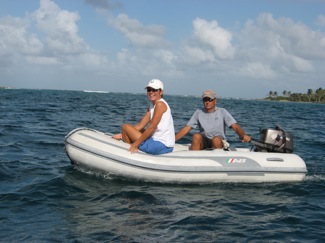

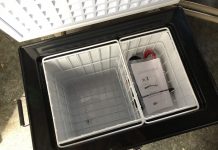
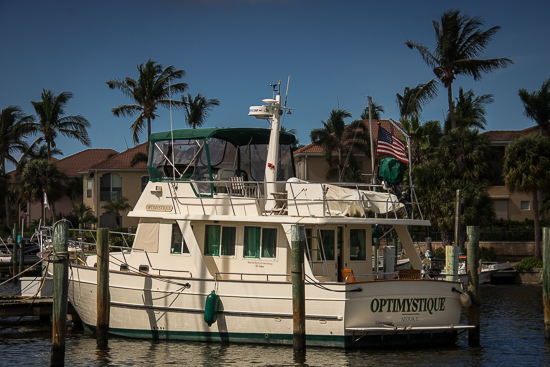







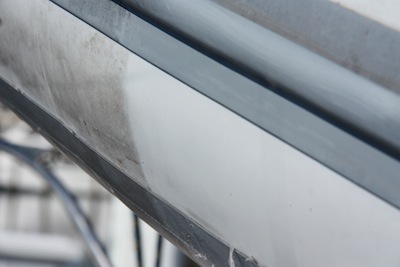
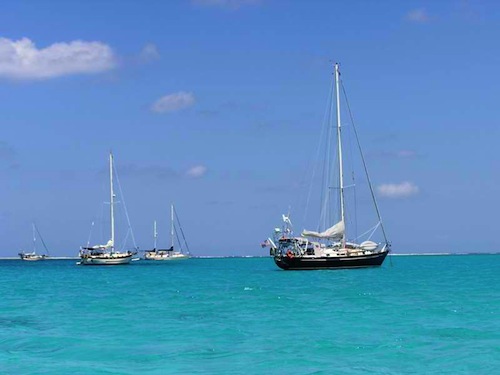
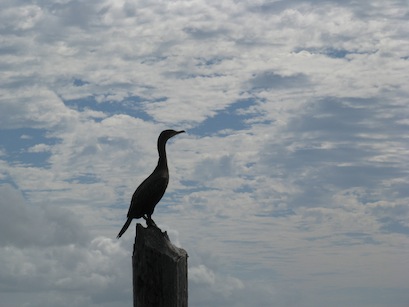
Another consideration in making a choice of dinghy is to add flotation tubes to a hard dinghy. Walker Bay makes tubes for their hard dinghy and we make Dinghy Dogs add-on tubes that can be added to most any hard dinghy, including Walker Bay. Get the best of both an inflatable and rigid dinghy at a much lower cost.
Just another option for your readers.
I have an 8 foot caribemissing it’s keil? Where can I get a new keil?
Have you any thoughts to share on inflatable catamaran dinghies? Here are several out there, including many that are not rigid, so can stow below deck. They have less wetted area and can go faster with a given engine.
Hi Tony! We have no experience, nor have I ever even seen an inflatable catamaran dinghy. The several you reference aren’t in Boot Key Harbor or Key West … at least that we’ve seen … and we’ve visited several crowded dinghy docks on a regular basis. Propane based outboards are making inroads though. Cheers! Jan